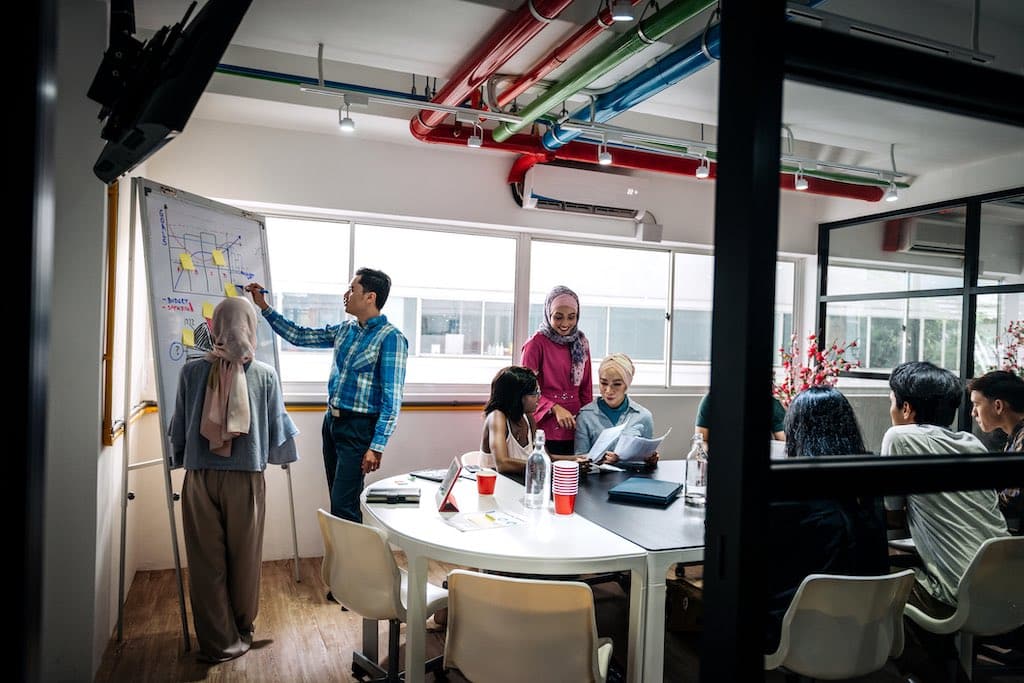This blog explores five key human factors that are particularly important to consider in government operating model transformation programmes.
5 key people considerations during government transformation

5 key people considerations during government transformation
This blog explores five key human factors that are particularly important to consider in government operating model transformation programmes.

Meet the author
In this, the second part of a two-part series on how to get the best out of your transformation, two of our operating model and change experts, Tom Carpenter and Archie Boyes, look specifically at central government. Here, Tom and Archie take a deep dive into the care needed when discussing people’s roles and responsibilities during a transformation in the public sector. See part one here.
Achieving the right operating model in government is hard, with commercial and supplier agreements, policy and geopolitical pressures, and shifting ministerial direction making transformation particularly challenging. Despite these complexities, it’s important to remember that at the heart of a government transformation is a unique workforce.
Even the best-intentioned transformations can signify a major change to the ways of working, culture, and ‘norms’ of an organisation, with 85% of transformations ending in failure if the workforce is not supported throughout the change. Therefore, if the unique people complexities in government are not considered in an operating model design and implementation, a transformation programme will often struggle from the outset. In our experience, five key human factors are particularly important to consider in government-operating model transformation programmes: (1) a careful approach to roles & responsibilities, (2) alignment to grade structures, (3) culture & hierarchy, (4) the composition of the workforce, and (5) leadership expectations.
Key workforce considerations during government transformation programmes
1) A careful approach to roles and responsibilities
Like any organisation, in response to sudden pressures or following gradual changes, a government department will need different things to achieve its long-term ambitions. For a department to transform its operating model and realise benefits, it will often need new skills, talent, and the right organisational structures. Making the most of in-house capability and exploring where people’s skills align is critical. However, if a department needs to propose changes to people’s job descriptions or expectations, this must be approached cautiously as these changes can significantly impact individuals’ roles, position in the organisation, and ultimately their wider career.
With civil service attrition, employment cases, and strike action at record highs, transformation leaders need to be careful not to place significant additional pressure on their people. When proposing structural changes to the workforce, thorough and empathetic consultation with the individuals involved, government leaders, and trade unions is essential. For more substantive changes to individuals’ job descriptions, additional support such as retraining will be required, as well as offering another role. Here, it is highly beneficial for transformation leaders to have a detailed understanding of the HR processes in place to manage changes in rewards and recognition. If they don’t have this knowledge, transformation leaders must consider bringing in the right council and support.
2) Grade structures
Many government departments have defined professions. Within these professions, specific roles are likely to be defined which align to the organisation’s grade structures and utilise Skills Framework for the Information Age (SFIA) bandings to define expectations.
When defining a new operating model in a private organisation, it is common to make alterations to roles or define new roles without the need for agreement centrally (although this brings about its own challenges). In the public sector creating new roles which aren’t already defined within professions can therefore be very difficult, time-consuming, and in some cases not possible.
This needs careful consideration during the design stage because professions tend to be centrally managed and aligned to SFIA bands. This means it can take significant time for new roles to be agreed. Although there can be some flex, the alignment of the role into current professions and the preferred grade should be understood before too much work is put into finalising the target operating model.
3) Culture and hierarchy
Many operating model changes today aim to reduce bureaucracy and siloing, increasing collaboration and empowerment. This shift to more progressive ways of working can be a major change for some areas of the public sector and it is important to remain aware that cultures, behaviours, and mindsets cannot be transformed overnight. As well as evaluating existing technology, skills, governance, and structures as part of your operating model design, it is critical to build a detailed understanding of the gap between current and desired behaviours, as well as any barriers to the desired state. Behavioural change frameworks, such as COM-B, can be particularly useful here and can help tailor operating model transformation interventions or designs that will embed desired behaviours.
In our experience, hierarchical structures, mindsets, and behaviours are a key cultural trend that remain prevalent across public sector organisations, representing one of the most significant cultural hurdles to overcome. These historic hierarchical structures can mean that, when decision-making is distributed following an operating model transformation, people feel uncomfortable with this new decision-making power or finding themselves being accountable for outcomes without more senior oversight. Consequently, these newly-organised government departments do not reap the rewards of distributing decision-making throughout the organisation.
People must be guided and coached in how to make the best decisions in their new role. They cannot be expected to immediately feel comfortable with taking more accountability and ownership. Training, support, and behavioural nudges can help build this capability – but eventually, people will need to take a leap of faith. It is important to position the balancing of support versus giving people the space to start innovating, helping remove the stabilisers whilst ensuring people feel they can raise concerns and that decisions can be reversed.
However, existing hierarchical behaviours and mindsets can also be leveraged to drive successful operating model transformation in the public sector. If leaders share a strong vision of where they want to be and allay fears about shifting roles and responsibilities, it can be plain sailing. Additionally, an empowering message from leadership can help the wider organisation feel more comfortable driving decisions, making mistakes, and learning from them. Providing psychological safety from the top will provide comfort and help people to lean into the changes a little more.
4) Workforce composition
In a given government department or function, the headcount of civil servants versus contractors or suppliers poses a unique challenge. Often, we have encountered areas of government departments where suppliers and contractors can make up as much as 40-50% of the workforce.
With this proportion of non-civil servants being so high, feelings of ‘us’ and ‘them’ can be more prevalent, making aligning on a shared vision and reshaping teams highly challenging in your operating model change. Additionally, reducing silos, improving collaboration and building empowerment – many of the goals of modern operating model changes – become stilted with almost half of the workforce bringing different cultures, ways of working, and a lack of continuity due to contract requirements such as IR35 (regulations that prevent contractors working more than 2 years as a ‘disguised employee’).
To enable government departments to continue making use of suppliers’ expertise whilst realising the benefits of a transformation, the aims of the operating model transformation should be incorporated into any contracting and review processes for suppliers. By evaluating at contractual level how contractors demonstrate the behaviours and values of your operating model change, agencies and suppliers are incentivised to take time to understand and buy-in to new ways of working.
Additionally, it is critical to integrate suppliers and contractors closely into your teams where possible, making a conscious effort to reframe suppliers as team members, rather than people from ‘X Consultancy’ or ‘Y Agency’. Here, emphasising the value that an individual contractor brings to the team’s success and introducing a feedback culture can help build stronger ways of working. Alongside structuring teams to have a healthy, collaborative balance between civil servants and suppliers, enabling suppliers to input into ways of working, vision, and values can help. By gathering this input from suppliers, government departments can make the most of the deep expertise these suppliers bring, maximising the benefits of both external support and the transformation.
5) Leadership expectations and alignment
Operating model change brings significant expectations and capability demands of leaders. Successful government transformation requires leaders to champion the change, steer the ship during a period of uncertainty, and tailor the transformation as situational factors arise. However, quite often, it is the leaders themselves who find it most uncomfortable to accept this new way of working as it requires a step into the unknown.
The easiest way to navigate this challenge and set leaders up for success is to ensure that, prior to any detailed definition of specific required changes, leaders are aligned on the value and reasons for the transformation. Once this alignment has been reached, leaders must agree on consistent messaging before communicating details of the change with the impacted teams. This agreed transformation purpose and benefits can then be referred back to and communicated with the wider organisation to guide teams through in the inevitable periods of uncertainty that change brings.
Once leadership alignment has been reached, public sector leaders must endeavour to move away from tactical management towards a more strategic focus. Most often, a key objective of an operating model transformation today is to enable effective execution of strategic objectives or to modernise the culture to be more people, user, and customer centric. This requires public sector organisations to move away from traditional centralised leadership structures, and adopt a modern, servant leadership style that builds leadership capability across the organisation, rather than standard practice of designating leaders by grade, level or role. Through building leadership capability, regardless of grade or position, distributed across and closely integrated into teams, the most senior civil servants will be freed from the tactical back and forth they are currently experiencing, freeing them to lead important strategic initiatives.
Conclusion
Operating model transformation is challenging and brings additional complexities in government. Of all the major facets involved in an operating model transformation, the people component is most critical to get right and neglecting this can railroad a transformation. Most government transformations fail to achieve their intended benefits because not enough effort is put into considering how people will be affected in the early stages. It is difficult to manage each of the human factors discussed in this article, but they can be addressed early through careful planning and design, enabling the workforce to be supported throughout the transformation and making sure it achieves its strategic objectives.
Do you need help with transforming your business or completing an organisational behaviour review? Our people and change management services may be able to support you. To find out more, please get in touch.

